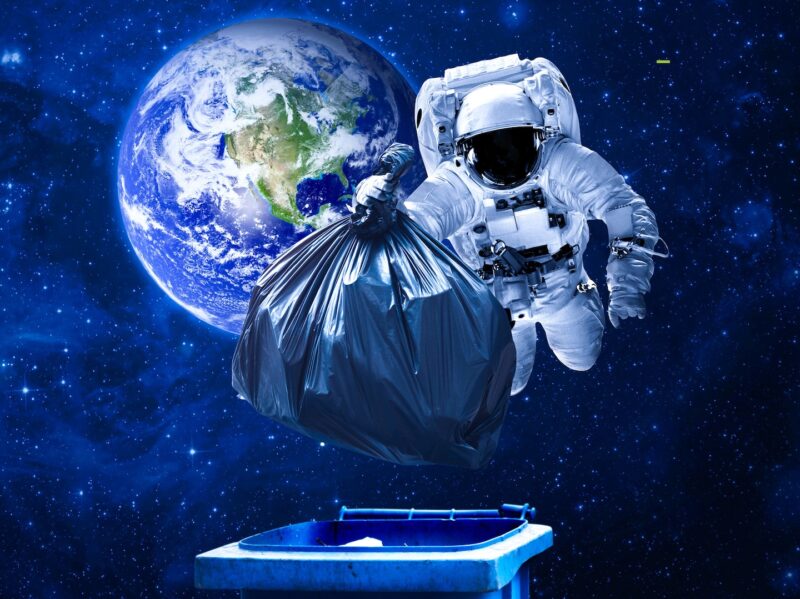Latest News

Via Satellite archive photo.
For at least two decades, there has been rising recognition and concern about a problem for our industry. Not a little problem. A big, hairy bodacious problem that could put our entire business out of business.
It’s the problem of keeping things in Earth orbit from smashing into other things. Space, with the support of the ground-based systems needed to operate there, has become a place where we do billions of dollars’ worth of business. That was unimaginable at the dawn of the Space Age, when we started littering the road to space with rocket engines, failed satellites, paint flecks and broken equipment.
But you know all that. The question is what we’re going to do about it. The answer for most of the past two decades has been: not much. Space debris, or space sustainability as it is now called, was the classic problem that we stared at without feeling able to solve it. Sure, Earth orbit held almost 100 million pieces of debris moving at blazing speed, giving a piece of junk no bigger than a softball the power to hit with the force of a bomb. And it could clearly get worse.
Nearly half a century ago, NASA scientist Charles Donald Kessler showed us how – describing a future in which one in-orbit collision led to more and more, creating a cascade that rendered Low-Earth Orbit (LEO) unusable. But hey, it would all be okay. After all, we had space safety rules – even if no one enforced them – and near-collisions were rare, even if the International Space Station was already dodging debris. Surely the challenge could be left to another day. Or as cartoonist Charles Schulz put it, “No problem is too big to run away from.”
What Changed?
In 2007, a deliberate Chinese test of an anti-satellite missile destroyed one of the county’s weather satellites and created 3,000 pieces of debris. In 2009, an accidental collision between Iridium and Cosmos satellites created another 2,000 pieces of debris still circling the globe. These two events suddenly made the industry and the governments of spacefaring nations take the rising crisis more seriously – seriously enough to start figuring out how we might find a business solution to a business problem.
Companies designed and launched in-orbit servicing vehicles in hopes of finding a market for them and experimented with specialized technologies to capture debris. It was a rocky road strewn with technology, cost and market problems. The science fiction writer Poul Anderson summed it neatly when he wrote: “I have yet to see any problem, however complicated, which, when you looked at it the right way, did not become still more complicated.”
But it took the power of Adam Smith’s invisible hand – aka, the market – to create real change. What happened was that we found a new use for LEO. Instead of just a place for earth observation, L-band and location services – which generated only a fraction of the revenue from satcom – LEO became a place to make serious money. First Starlink, then OneWeb, proved that LEO internet and committed-information-rate communications were, first, feasible, then possible and then apparently profitable, if the latest Starlink estimate from Quilty Analytics is correct. Amazon Kuiper is coming up fast to join the pack.
Making Tough Decisions
Suddenly, we could put a future monetary value on LEO instead of staring blankly at a remote forecast of doom. The need to stop creating more debris was met by new regulations from the U.S. Federal Communications Commission, which tightened the time required to deorbit a LEO satellite from the generous 25 years to just 5 years after launch. The business plans of in-orbit servicing and debris removal companies are no longer built on the hope that someday, somebody will need to clean up and optimize the value of LEO and MEO. Robert Schuller might have been thinking of space safety when he wrote, “Again and again, the impossible problem is solved when we see that the problem is only a tough decision waiting to be made.”
Now it’s possible to do more than just stare at the impossible problem of space sustainability. We can look at it as a challenge we may actually rise to, not because we are brave and true, but because some investors have a chance to get paid. Having a positive attitude about our future in space is not just for dreamers anymore. It can actually be a lot of fun, as another anonymous wit teaches us: “A positive attitude may not solve your problems – but it will annoy enough people to make it worth the effort.”
 Robert Bell is executive director of Space & Satellite Professionals International. SSPI produces the Better Satellite World campaign, which dramatizes the immense contributions of space and satellite to life on Earth. More at www.bettersateliteworld.com.
Robert Bell is executive director of Space & Satellite Professionals International. SSPI produces the Better Satellite World campaign, which dramatizes the immense contributions of space and satellite to life on Earth. More at www.bettersateliteworld.com.
Stay connected and get ahead with the leading source of industry intel!
Subscribe Now